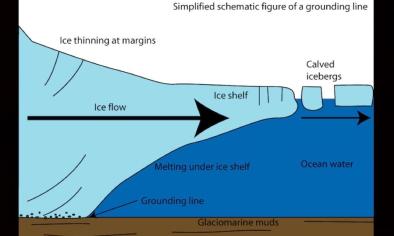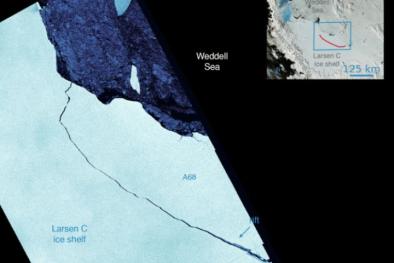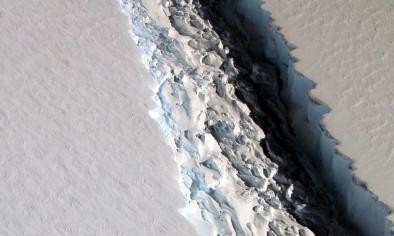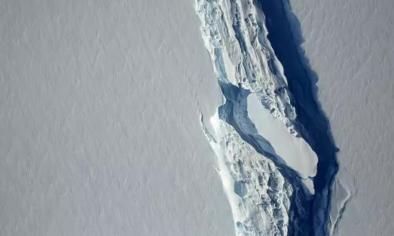Mysterious Winds Cause Rapid Melting of Antarctic Ice
....
After studying Antarctica’s warming climate for decades, scientists are making a surprising discovery: In some places, much of that abnormal warmth is invading in the form of powerful, downhill winds called föhn (pronounced “fone”) winds. Pettit, a glaciologist from the University of Alaska in Fairbanks and a National Geographic explorer, now suspects that these winds contributed to a series of dramatic glacial collapses that have been steadily redrawing the map on the east side of the Antarctic Peninsula for the last 30 years. Föhn winds may have escaped scientists’ notice because they don’t just blow during summer—some of their most impressive heat waves actually strike in the dead of winter, eroding glaciers at a time of year that no one thought possible.
“They seem to impart a lot more melt onto the ice shelf than we had imagined,” says Adrian Luckman, a glaciologist at Swansea University in the United Kingdom, who studies this region of Antarctica.
...
The peninsula stretches 700 miles upward into the Southern Ocean. Its mountainous spine rises 5,000 to 9,000 feet above sea level, capped with a plateau of ice—forming a wall that usually diverts the circumpolar winds northward around it. The east side of the Peninsula, shielded from these winds, is especially cold. For thousands of years, it was flanked by a series of vast ice plains—so-called “ice shelves,” 800 feet or more thick, which float on the ocean, extending up to 150 miles out over it.
The ice shelves had formed as dozens of glaciers oozed off the coastline of the peninsula, merging their ice into a vast apron that spread over the sea. But all of this began to change in 1988.
One by one, the ice shelves on the east side of the peninsula began to collapse. The first two ice shelves simply went missing—present at the beginning of a summer, then gone by the end. But the collapses of Larsen A ice shelf in 1995 and Larsen B in 2002 were violent events, documented by human witnesses and satellite photos.
...
Larsen A and B showed similar symptoms leading up to their disintegration. Both ice shelves lost their insulating cover of snow, laying bare a darker, icy surface that absorbed more heat from the sun. Melt ponds grew and metastasized across their surfaces. Then this water drained into deep cracks in the ice. Its weight pushed the cracks ever deeper, like a wedge, until it broke through the bottom, says Theodore Scambos, a glaciologist at the National Snow and Ice Data Center, who has studied these ice shelves for many years and camped with Pettit in Antarctica last February.
...
Any new snow that fell during the winter had been obliterated by winds. Scambos, Pettit, and a handful of other scientists now suspect föhn winds helped set the stage for recent ice shelf collapses. These events continue to have far-reaching consequences.
...
Continued climate warming is expected to increase frequency and strength of föhn winds on the peninsula, says Pettit.
...
Scambos is already seeing their impact, in satellite images of the area. The ice shelf appears darker than usual, as does the surface of the sea ice that sits in front of the ice shelf. “The areas of high wind speeds and warm winds are evaporating the snow, probably melting it a bit too,” he says—exposing older, bluer ice on the surface.
That darker ice will absorb more heat during the Antarctic summer from November to February, creating large melt ponds that could trigger the final collapse of Scar Ice Shelf.
...
The winds also threaten the ice shelf in another way. Ever since Larsen B collapsed in 2002, a flotilla of sea ice, some if it greater than eight feet thick, has pushed up against the front of Scar Inlet, bracing the remaining ice shelf and holding it in place, even as the glaciers that push into it are tearing it apart.
But satellite photos now show that in just the last few weeks, föhn winds have pushed much of that stabilizing ice out to sea, with more disappearing each week. That remaining rim of protective sea ice bears similarity to a Gothic arch supporting a building overhead, says Pettit: “If you take the key piece out, the whole arch collapses.” The Scar Ice Shelf that it was supporting will also collapse
...
On June 10, a team of British scientists led by Luckman reported a disturbing discovery on its north end. Larsen C should be covered by 200 feet of insulating snow. But they found that in some places, all but 10 feet of it had already vanished—erased, in part, by föhn winds.
Related Content






